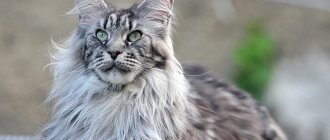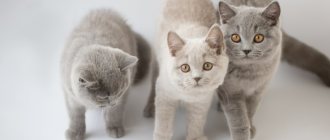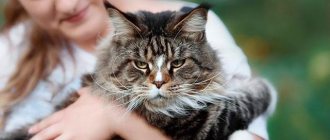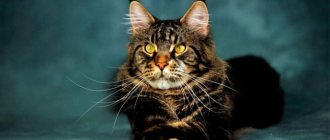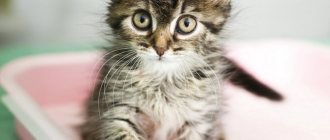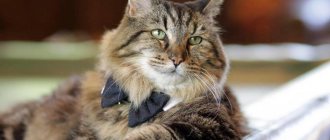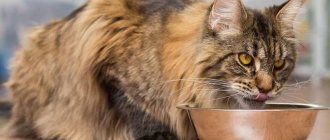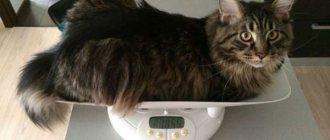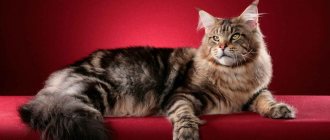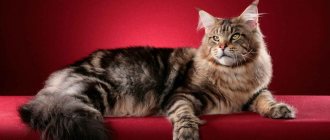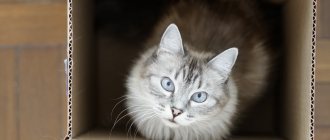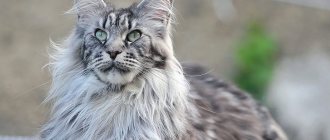Unique voice
From birth, all Maine Coons have a uniquely gentle voice, which becomes louder over the years, but still not louder than the voice of ordinary cats. It’s strange that no one has thought about recording an album with them yet. After all, it is only because of the bird's voice that it is worth having at least one of them. If you have never had a parrot or any other bird, then you can start with a Maine Coon; by ear you won’t even notice the difference. Don't believe me? Be sure to check it out for yourself. It’s easy to describe this voice, it is similar to the voice of a magpie, only in terms of energy it is many times stronger and brighter, especially when Maine-kun asks for food! Scientists have not yet agreed on why Maine Coons have such a voice; many complain about special vocal cords, but it is worth noting that if an ordinary cat’s voice becomes different over the years, then in a Maine Coon it simply becomes louder!
Maintenance and care
In order for the pet to feel comfortable, it needs to be provided with a territory sufficient for its size and provided with everything necessary for everyday cat life. Essential items include:
- Little house. You can make it yourself or buy it in a store. The best option would be a multifunctional complex, including a booth, a bench and several observation platforms installed at different heights.
- Carrying. A necessary item for trips to the veterinarian and traveling any distance.
- Scratching post. Can be purchased separately or as part of a gaming complex.
- Utensils for eating and drinking. It must be of a suitable volume and weight so that the pet cannot knock it over. For greater convenience, you can install an automatic drinking bowl.
- Toilet tray. When choosing this item, you must take into account the size of the animal. For safety reasons, it is recommended to use natural filler.
To care for a Maine Coon you will need special tools and equipment:
- Several types of combs: with rare movable teeth, frequent metal teeth, a brush with natural bristles.
- Furminator is a device designed to remove dead fur. It is recommended to use both during the period of shedding and in its absence to improve the quality of the coat.
- A nail clipper is a device for regularly trimming claws.
- Cat toothbrush and toothpaste.
- Shampoo with conditioner for long-haired breeds.
Regular brushing
The procedure should be carried out 1-2 times a week. More frequent grooming may be required during shedding. First, the coat is combed with a sparse comb, and only then a comb with thick teeth is used. Individual areas of the body are processed in the following sequence:
- tail;
- back;
- side zones;
- breast;
- "pants";
- stomach.
The resulting tangles must be disassembled by hand or carefully cut with scissors.
Water treatments
Maine Coons, like other cats, do not need frequent bathing. The animal should be washed on the eve of the exhibition or if it is heavily soiled.
Before bathing, your pet's ears must be protected with cotton balls. It is recommended to place a rubber mat at the bottom of the bathtub to prevent the cat's paws from slipping.
The patient should be bathed in warm water, the temperature of which does not exceed 38°C. It is advisable to use shampoo with conditioner designed for long-haired breeds.
If your pet flatly refuses water treatments, you can clean the animal’s coat with dry shampoo.
Grooming is not for the Maine Coon
According to experts, the Maine Coon's coat is not intended for grooming. Firstly, a “fashionable” haircut does not suit a descendant of Aboriginal people. Secondly, the highlight of the breed - its wild charm can be lost forever.
Already after the first use of cutting devices, the structure of the coat is disrupted. The fur coat irreversibly loses its smooth guard hair. All that remains is fluff, reminiscent of cotton wool.
In Maine Coons, as an exception, it is allowed to trim the hair in the groin area and under the tail. Such intervention is justified by hygienic purposes and does not disturb the exterior. You can carry out this procedure yourself or seek help from a specialist.
What is the weight of an adult cat and Maine Coon cat?
The size and weight of a kun depends on many factors. The state of an adult cat is established at birth. The size of the animal is affected by:
- Genetics. If the kitten's parents were large and in good health, there is a high probability that the kittens will also be of impressive size.
- Floor. Males are larger and taller than females. Males also grow faster than their female counterparts.
- The use of hormonal drugs in a cat during certain periods.
- Conditions in which kittens grow up.
- Stress factor. If an animal is constantly exposed to stress, the endocrine system of the animal suffers first, which negatively affects further growth.
- Proper nutrition. It must be balanced. By following proper nutrition, healthy and strong coons will grow up with the correct size and weight.
Typically, a cat stops growing and gaining weight at the age of three. During this period it should reach its maximum size. For a male, the weight can range from 9-12 kg, castrated individuals can weigh 13-16 kg. All cats should be between 7-10 kg. The height at the withers can reach 25-40 cm. The length of the body from the nose to the tip of the tail can reach 100 cm, that is, 1 m. The maximum length established by the kunas is 1.23 m.
Thoroughbred animals with a good pedigree will look larger and more massive than their counterparts. This is dictated by a special genetic exterior.
Weight table by age
The development of the animal occurs quite evenly, but a jump in growth processes, as a rule, occurs in the fourth or fifth month of a pet’s life:
| Age | Male weight | Female weight |
| a week | 240-280 g | 240-260 g |
| two weeks | 250-350 g | 300-400 g |
| month | 630-820 g | 560-740 g |
| two month | 1.23-1.50 kg | 1.1-1.4 kg |
| three months | 1.8-2.3 kg | 1.7-2.3 kg |
| four months | 3.0-3.8 kg | 2.7-3.6 kg |
| five months | 3.2-5.5 kg | 2.9-4.3 kg |
| six months | 3.5-5.8 kg | 3.0-4.5 kg |
| seven months | 4.2-6.5 kg | 3.5-4.9 kg |
| eight months | 4.4-6.8 kg | 3.8-5.2 kg |
| nine month | 5.1-7.2 kg | 4.1-5.5 kg |
| ten months | 5.3-7.6 kg | 4.2-5.8 kg |
| eleven months | 5.6-8.1 kg | 4.3-6.1 kg |
| twelve months | 5.7-9.0 kg | 4.5-6.8 kg |
| one and half year | 6.0-9.5 kg | 4.5-7.0 kg |
| two years | 10.0 kg | 4.7-7.3 kg |
| two and a half years | 12.0 kg | 7.5 kg |
| three years | 13.0-16.0 kg | 7.5-8.0 kg |
Return to content
They are friendly but not tame
It is almost impossible to tame a Maine Coon completely; they have a wayward, daring character that they retain for the rest of their lives.
Probably everyone has seen photos in which people hold Maine Coons and straighten them to their full width, and you can see how huge they are.
They are really larger than ordinary cats, it’s all about special selection. It’s not for nothing that this is considered a royal breed of cats, since they are from those same Imperial times. If you manage to tame such a “miracle”, then you should definitely think about a circus career! He is the owner of the house and not you, and it is better for you not to argue with this, otherwise there will be a lot of scratches, and it is better not to lead to bites
Birth weight
Maine Coons are the largest domestic cats in the world.
Their kittens at the time of birth weigh on average about 115-120 g. Girls are born smaller - 85-145 g, boys - 100-170 g.
Maine Coons are the largest domestic cats in the world
It has been observed that large newborn Maine Coons grow faster than their smaller counterparts.
Why can a Maine Coon lose weight?
Body weight standards affect the portion of food that domestic coons should receive. If suddenly your pet begins to lose body weight, this may indicate the presence of health problems. It is important to take action in time and contact a veterinarian. Typically, there are many reasons for weight loss:
- change in diet or diet;
- poor nutrition;
- use of low-quality products;
- worms or other parasites;
- hereditary factors;
- hormonal imbalances;
- poor animal hygiene;
- serious illnesses.
At the first signs of weight loss, it is worth paying attention to the animal’s diet. Perhaps it is not receiving enough necessary nutrients. If there have been no changes in the diet, the cause may be the stressful state of the coon. In any case, weight loss is most often due to health problems. In this case, only specialists can help and immediately prescribe adequate treatment.
Material on the topic: all about the character and habits of Maine Coons.
Maine Coon kitten.
Useful tips and tricks
The most important task for the owner of a Maine Coon kitten is to create the right diet for him, which will ensure the normal growth and development of the animal. For coons, natural food is preferable as it is most suitable for them. Veterinarians consider poultry, rabbit, and beef to be the most appropriate. Milk can be given to small kittens; it is not suitable for adults.
Now a number of manufacturers offer specialized food for their owners. They are produced keeping in mind the body weight and size of this cat breed. Such food can be combined with natural food. Veterinarians do not have a consensus on what type of feeding should be chosen. Each owner determines this independently for his pet.
They don't like loneliness
Maine Coons always strive for the room where there is a person; without attention, they suffer greatly. They, as a rule, choose one owner and remain devoted to him for life. If your cat chose you out of all the family members, then you are very lucky, but there are disadvantages: he is unlikely to give you privacy in the toilet or shower. The doors in the room you are in should always be open. These animals generally hate loneliness: even if you leave the house for just a couple of hours, the Maine Coon will greet you with violent screams. But cats of this breed are easy to teach dog tricks. Our pet always comes when called and knows how to fetch. Some owners even boast that they taught their pet the “sit” command. It’s better for you to always be close, otherwise they may be offended by you and will never let you caress them again. Therefore, either take it with you always or don’t start it at all.
How to distinguish a purebred kitten when buying
Distinctive features of the Maine Coon breed that will help you avoid making mistakes in choosing a pet.
Characteristic signs
- At 5 weeks, the size of a Maine Coon corresponds to the parameters of a regular six-month-old kitten; at 4-5 months they reach the size of an adult cat.
- The eyes are almond-shaped and slanted; other cats have round eyes.
- Large ears are located perpendicular to the head, there is no forward tilt. Wide at the base, they gradually taper upward, and tassels are observed at the tips - an exceptional external sign that most often appears by 3 months, although sometimes it can already be present at birth.
- The length of the head is greater than the width, so it is slightly elongated. The cheekbones protrude significantly, which is not the case in ordinary domestic kittens. The features are clear. A “box” is formed in the area of the mustache and chin, which makes the muzzle square.
- Large paws with fur between the claws.
- The tail is 2 times longer than that of ordinary kittens.
- Thick coat of medium length.
- The body is strong, the bones are massive, and the chest is wide.
Regular kitten and Maine Coon
There are some differences between a Maine Coon and a regular kitten. Breeders monitor intraspecific crossbreeding so as not to lose the characteristics of a purebred cat. Pets are born weighing 100-150 g, and by 3 months they grow to 2-2.5 kg. Strong and active, they develop quickly. Eyes open early.
The coat is fluffy and thick from the moment it is born. Powerful chest. The head is extended upward, as the length is greater than the width. The tail is long and bushy, and the paws are large with hair between the claws. They begin to eat regular food at an early age.
The guarantee of an animal's thoroughbredness is its pedigree.
A newborn ordinary kitten weighs 80 - 100 g. By 3 months the weight is only 1-1.5 kg. Small and blind, they rest a lot. Less active and late trying to get on their paws.
They feed on mother's milk for a long time and only with the appearance of their first teeth do they switch to food.
It is worth purchasing a pet from 3 months, at this moment the signs of a purebred pet will be clearly expressed. And you certainly can’t go wrong on how to distinguish a Maine Coon from an ordinary kitten.
Differences from mestizo
Crossbreeds still occur, although interbreed matings are prohibited. It is difficult to distinguish a mestizo from a real Maine Coon, since the former have the external features of purebred pets. It is better to consult a specialist who will help you determine whether the cat in front of you is a purebred or a fake.
A Maine Coon is considered purebred if ancestors in 4 generations are mentioned in the pedigree. Outbred and mixed animals only have a veterinary passport, which the owners do at their own request. Pedigree records are not issued.
A distinctive feature of a purebred pet is its size. The weight of an adult Maine Coon is at least 6-7 kg. Also, mixed-breed kittens look much smaller than their purebred counterparts.
You should also pay attention to the cost of the pet: mixed breeds are sold at a lower price than purebred ones.
Siberian kittens and Maine Coons
When comparing kittens of two species, you can see their pronounced similarity to their wild forest counterparts: Maine coons resemble lynxes in their habits, and Siberian kittens are remotely similar to manul cats.
Maine Coons have an elongated body with a long neck. The muzzle, as if chiseled, with sharp transitions, strongly pronounced cheekbones, with a clearly defined chin located in line with the nose, is one of the features of these cats. The ears point upward and have tassels at the tips.
In addition, this breed has large slanted eyes, which can only be found in purebred representatives. They have different colors. Only varieties of chocolate, fawn, cinnamon and acromelanic combinations are considered not to have received recognition.
Siberian kittens are more densely built, they have a short and powerful neck. The lines of the muzzle are smooth, the chin is rounded, the cheekbones are set low. Deeper and wider chest. The ears are round, slightly tilted forward.
The roundness of the back is also observed. Siberians have shorter paws, which is why the Maine Coon is much taller.
Appearance Features
It is worth knowing that at a young age it is quite difficult to notice the difference between animals. Thoroughbreds have similarities to ordinary ones, but they still have unique features. When inspecting, pay attention to:
- Ears. They are noticeably larger than those of ordinary pets, set almost at a right angle to the head, there is no forward bend, like in a Siberian cat. They are wide at the base and then gradually narrow. They end with a tassel - a unique external feature. The kitten can be born with it, more often it grows later, but by a maximum of 3 months there should already be a tassel on its ears. For this reason, it is better to select a pet at this age.
- Head. It is slightly elongated, since the length is slightly greater than the width. All features are clear, and the whisker pads form a “box”, making the muzzle square. The cheekbones protrude noticeably, which is not typical for ordinary domestic kittens.
- Eyes. They are slightly slanted and almond-shaped, unlike the rounded ones of other cats.
- Paws. Firstly, they are quite large even in babies, and secondly, tassels also grow on them - between the claws.
- Tail. This part of the body in purebred animals is long, about 2 times longer than in their domestic relatives. It is worth noting that selling Maine Coons is a profitable business, and there is a high risk of fraud. The breeder can tell that the tassels have not yet grown, the shape of the face sometimes seems similar, but the length of the tail can reveal the truth. Therefore, it is better to cooperate with reliable nurseries, where they will provide you with all the necessary documents.
- Wool. Even in kittens it is of medium length and thick.
- Dimensions. At the age of five weeks, Maine Coons are already comparable in size to a six-month-old ordinary kitten; at 4-5 months they “catch up” with an adult.
- Body type. It should be strong, the chest should be wide, the bones should be massive.
Also, purebred representatives of the breed are much more active and mobile than their ordinary counterparts, they develop faster and switch to food earlier.
Origin story
People have always loved to invent legends about various natural phenomena and stories that happened in various cities around the world. The Maine Coon is also not without amazing stories about him. There is so much fantasy, humor, and sometimes even absurdity in them.
An amazing romantic legend tells how this cat breed was created. The distant ancestors of the modern Maine Coon were cats that lived in the chambers of Marie Antoinette. When the French Revolution began, the queen decided to flee to America. Taking with her the most valuable things, including cats, she solemnly handed them over to the care of Captain Samuel Clue. They say that the queen had tender feelings for him. Marie Antoinette was soon caught and executed. But the captain managed to complete his assignment. He went to his native land - the city of Wiscasset, Maine. Having released the cats into the wild, they immediately made friends with the locals and soon gave birth to a new generation, which it was decided to call Maine Coon.
The second mysterious legend is the story of Captain Kuhn, who loved to wander the shores of New England. He loved cats, so he had a Persian cat and an Angora cat on board. At every port he visited, he released his pets for a walk. They were in a hurry to make friends with local cats. So Maine Coon kittens appeared everywhere he went.
The third fantasy story tells a completely different version of the origin. The first Americans who managed to tame Maine Coons believed that they were the result of crossing an ordinary cat with a raccoon. This is evidenced by the characteristic color, fluffy tail and the presence of tassels on the ears.
It's nice to know the legends, but in reality it was all pretty banal. This is one of the oldest breeds that lives in North America. A cat with a powerful physique appeared in the homes of the first settlers around the middle of the last century. The state of May has harsh winter conditions. Short-haired cats would be unlikely to survive, but not Maine Coons. They have thick, long hair and a warm undercoat. The presence of fluff on the paws prevents them from freezing when they run in the snow. This is a real "child" of the state of May. Here's the real origin story.
Owners of farms and large estates were in a hurry to get the breed, as they are considered excellent hunters. Maine Coons served their owners, successfully catching and destroying mice and rats. Very soon they appeared before the whole world in a completely new role when the first Maine Coon appeared at a cat show and won first place.
Varieties
Despite its American origin, the breed was established and developed mostly on European territory.
Local breeders were developing new lines. As a result, certain external signs and character traits characteristic of modern Maine Coons have become established.
This is how two varieties of this breed were formed: American and European.
American type
Cats of this species are classic representatives. American breeders work to preserve their original appearance and purebred quality.
Aborigines have a number of distinctive features, the main of which are:
- strong skeleton;
- well-developed muscle tissue;
- wide chest;
- voluminous skull;
- high forehead;
- short muzzle;
- round eye shape;
- high-set small ears;
- long whiskers;
- bushy tail;
- very thick and long hair;
- pronounced tabi color with a clear contrasting pattern.
European type
In the 70s of the 20th century, breeders managed to develop a new intrabreed variety. European Maine Coons are significantly different from Aboriginals. They are characterized by the following signs:
- extended body;
- elongated wedge-shaped muzzle;
- low forehead;
- high-set large ears with “lynx” tassels;
- slanted, oval-shaped eyes;
- high limbs;
- a long tail;
- moderately pronounced coat, lack of a lush mane and “pants”;
- plain smoky color.
In addition to “pure” representatives of each type, there are individuals that combine the external features of both varieties.
Record holders
The largest Maine Coon in history had a body length of 123 cm. The tail was 41.5 cm long. This cat had a gray-smoky color, and the record itself was recorded on August 28, 2010. His name was Stewie, he lived in the USA, in the state of Nevada. Another record holder lived in Australia, his name was Omar. He weighed 14 kg. It had a length of 120 cm.
Maine Coon record holder.
One of the most sensational records concerning this breed lived in Australia and had similar dimensions.
The largest cat by weight lived in the USA. He reached a weight of 16.5 kg, and did not have any health problems that could cause such a body weight.
No artificial records
In order to achieve records, many owners begin to overfeed the cat or even introduce special hormonal supplements to quickly gain height and weight, thereby harming its health. Large weight impairs the functioning of the heart, liver, digestive tract, and also leads to metabolic disorders. This way the animal can die much faster. All this led to the fact that many international exhibitions and competitions canceled awards in this category.
Coat and color
Maine Coons are semi-longhaired cats. They have thick, shiny and silky fur.
Guard hairs on different parts of the body have different lengths. The short ones cover the area of the head, shoulder blades and limbs, the longer ones grow closer to the tail. The belly, sides, “pants” and “collar” are quite fluffy.
The undercoat is well developed. It is soft to the touch, quite dense and waterproof.
Color – natural, varied. The most common wild colors are black and red marble, black tiger. In Russia, Maine Coons are often white and have various shades of agouti.
Artificial colors (lilac, chocolate, colorpoint, sorel, fawn) are not recognized by most felinological organizations, since they may be the result of interbreeding.
A characteristic feature of cats of this breed is thick and long hair! Short guard hairs grow only on the head and paws of the animal.
If a short-haired or smooth-haired individual is offered under the guise of a Maine Coon, it is likely that it is not a purebred.
Health and illness
Representatives of this breed also surprise with their good health, they have innate immunity, and they rarely get sick. But it’s still worth considering that they can be overtaken by some diseases that are difficult to treat:
- polycystic kidney disease;
- heart ailments;
- amyotrophy.
In the presence of such ailments, there is nothing left to do but maintain the stable condition of the pet.
Don't forget about routine vet checks, vaccinations and deworming.
Education and training
Observation post
Despite the fact that modern coons no longer chase mice through the pine clearings of Maine, the genes of wild ancestors in the representatives of the breed will definitely remind you of themselves. Accordingly, by adopting a Maine Coon, you have the added bonus of the opportunity to practice self-discipline.
In general, “Manx raccoons” are easy to train: they have a phenomenal memory, allowing cats to easily and quickly remember commands. Difficulties with the correct operation of the tray and the use of sofa upholstery instead of a scratching post are definitely not about Maine Coons; the furry giants easily master these wisdom even at a very young age. From time to time, cats need to give vent to their emotions and hunting instincts, so it is very advisable to take part in the pet’s games. Buy your Maine Coon a special ball, a toy mouse, or tease him with a laser pointer, thereby provoking the animal’s hunting excitement.
Kitten development
The weight of Maine Coon cats depends not only on the genetic reserve, but also on how responsibly the owner of the animal treats nutrition. Height and weight vary at different stages of a kitten's development, but should always be consistent with each other.
Cats are immediately born large, and the greater the weight of the newborn, the larger the adult cat grows. Surely, you are concerned about the answer to what age Maine Coons grow. Fluffy cats actively increase in size until about a year old, then such a sharp pace decreases, but development continues until 3-4 years.
The growth stages of cats can be divided into 4 periods:
- The neonatal period of life lasts 4 days.
- In the first month it is a sucker.
- Then transitional, when the cub tries adult food. About three weeks pass, while the babies, adapting to new food, reduce their indicators of physical development.
- And after the post-suction period, at this time the kittens finally switch to independent feeding.
The structural features of the body, large muzzle and long hair of furry giants make them seem much more massive than they actually are.
What affects growth
The cat grows up to 3-4 years, during which time the body length reaches an average of 1 meter. Of the recorded records, the longest cat in the world is 123 cm. There have been cases when the animal reached 135 cm.
In cats, the height at the withers is 30-40 cm. Parameters such as the weight of the cat and its size do not depend only on the health and gender of the kitten. High-quality care and proper nutrition for Maine Coon cats, timely examinations, living conditions, these are the factors influencing the weight of the animal.
It is important to monitor the health of your pet and select a diet according to age. The food must be of high quality. The maximum portion that a pet eats should not exceed 250 grams.
For boys and girls the figure is approximately the same. Meals should be divided into 4 servings up to a year and limited to 2 meals after. Do not feed the animal to a huge size; a fat cat is more susceptible to disease. Proper care not only ensures proper development, but also significantly prolongs life.
